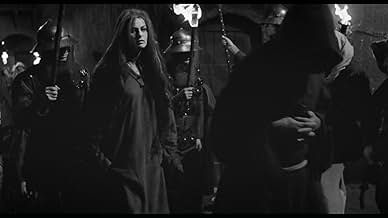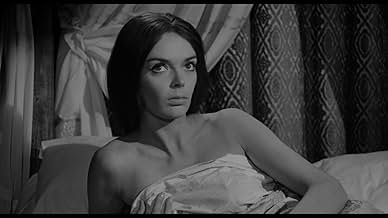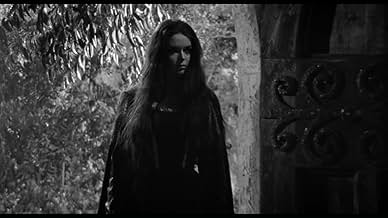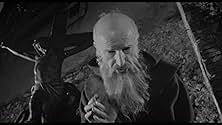IMDb रेटिंग
6.2/10
2 हज़ार
आपकी रेटिंग
अपनी भाषा में प्लॉट जोड़ेंA woman under suspicion of witchcraft is burned alive. Her curse brings her back from the dead for revenge.A woman under suspicion of witchcraft is burned alive. Her curse brings her back from the dead for revenge.A woman under suspicion of witchcraft is burned alive. Her curse brings her back from the dead for revenge.
Umberto Raho
- Von Klage, the Priest
- (as Robert Rains)
Laura Nucci
- Grumalda
- (as Laureen Nuyen)
Giuliano Raffaelli
- Count Humboldt
- (as Jean Rafferty)
Nello Pazzafini
- Monk, the Servant
- (as John Carey)
Aldo Barozzi
- Plague Victim
- (बिना क्रेडिट के)
Mario Casella
- Gorca
- (बिना क्रेडिट के)
Severino D'Ottavi
- Party Guest
- (बिना क्रेडिट के)
Alba Maiolini
- Wife of Plague Victim
- (बिना क्रेडिट के)
Aldo Massasso
- The Priest
- (बिना क्रेडिट के)
Enzo Mondino
- Villager at the Execution
- (बिना क्रेडिट के)
Piero Pastore
- Baron Von Letz
- (बिना क्रेडिट के)
Sylvia Sorrente
- Gorca's Wife
- (बिना क्रेडिट के)
Terry Velasco
- Gorca's Daughter
- (बिना क्रेडिट के)
फ़ीचर्ड समीक्षाएं
Well, it's obvious that The Long Hair of Death takes a lot of its influence from the Mario Bava masterpiece 'Black Sunday', but even so; Antonio Margheriti's film manages to deliver a good horror story in its own right. The plot is pretty much your classic Gothic horror yarn, and focuses on a small village. A woman is accused of being a witch and promptly put to death. However, her eldest daughter knows the real reason for her death revolves around the lord, and she's promptly killed also. The youngest daughter survives and is taken in by the murderous lord's family, eventually marrying his son. Soon after, a deadly plague threatens the village; and the older daughter reappears to avenge her mother's death. The main standout of this movie is definitely the atmosphere - director Antonio Margheriti does an excellent job of giving the movie a foreboding feel through the eerie black and white cinematography and the imposing sets. The plot can drag a bit at times, which is a shame; and so it's lucky that Margheriti was able to give the film an atmosphere as it keeps it going when the plot takes a downturn.
Another standout about this film is, of course, the fact that it has a leading role for Barbara Steele. Of course, she was almost certainly cast because of her success in Black Sunday, and as such; this isn't her greatest performance, but she's always nice to see and she does play the resurrected woman well. It does quite often seem like Margheriti is dragging the plot out and this is a shame as the film is overlong as a result and it has to be said that The Long Hair of Death would have benefited from a shorter running time. Antonio Margheriti made some good films in his career, though the fact that he doesn't get good recognition along with the likes of Sergio Martino and Lucio Fulci doesn't surprise me. This film was released in between Margheriti's successes with The Virgin of Nuremberg and Dance Macabre, and although I prefer both of the mentioned films; this one is still worth seeing for the Italian Gothic horror fan. The film boils down to a somewhat predictable ending, but it's a nice ride getting there and overall, despite the fact that The Long Hair of Death may not be the most successful film of it's type - it's still worth a watch.
Another standout about this film is, of course, the fact that it has a leading role for Barbara Steele. Of course, she was almost certainly cast because of her success in Black Sunday, and as such; this isn't her greatest performance, but she's always nice to see and she does play the resurrected woman well. It does quite often seem like Margheriti is dragging the plot out and this is a shame as the film is overlong as a result and it has to be said that The Long Hair of Death would have benefited from a shorter running time. Antonio Margheriti made some good films in his career, though the fact that he doesn't get good recognition along with the likes of Sergio Martino and Lucio Fulci doesn't surprise me. This film was released in between Margheriti's successes with The Virgin of Nuremberg and Dance Macabre, and although I prefer both of the mentioned films; this one is still worth seeing for the Italian Gothic horror fan. The film boils down to a somewhat predictable ending, but it's a nice ride getting there and overall, despite the fact that The Long Hair of Death may not be the most successful film of it's type - it's still worth a watch.
"I lunghi capelli della morte" by Antonio Margheriti is a classic b/w Gothic movie. Take a flickering candle, go down into the crypt, past the spider webs - and you wouldn't be surprised if Bela Lugosi was lurking in the shadow. Actually it's Barbara Steele which you can't complain about, either. Giorgio Ardisson plays Kurt, the son of a Count, who commits a murder, blames it on a witch, the witch is burnt and leaves a terrible curse behind - maybe the story is not something new, but it matters most in this movie to show how a man is slowly trapped in a revenge plan - so slowly that for most of the running time, he doesn't even realize the torment already began. That not much is happening, as sometimes reviewers do say, is done on purpose: Kurt would like to move, but he is becoming aware more and more of his helplessness, his inability to hide. "I lunghi capelli della morte" is a movie with intensity, atmosphere and beauty in its black and white imagery, and while I just wanted to check out the first chapter for the disc quality when the DVD arrived in the mail, I ended up watching it till the end - it was mesmerizing and really that good. Fans of the genre, don't miss it!
A woman is burned for being a witch. Her daughter, Helen Karnstein (Barbara Steele) vows revenge, but is pushed off a cliff before she can carry it out. The younger sister, Elizabeth (Halina Zalewska), grows up and is forced to marry the man who framed her mother. Then one stormy night, Helen rises from the grave. Elizabeth's husband immediately falls for Helen and together they plot to get rid of Elizabeth. Will Helen really help kill her sister, or is it part of a plot to finally get revenge for her mother's death?
If you're a fan of either Italian B&W ghost stories or Barbara Steele, there's a lot here to enjoy. There's just something about B&W that seems to work for me in a ghost story. B&W makes Gothic lookwell, more Gothic. Color never works as well for me with this kind of movie. The eerie passageways of the castle, the witch burning scene, and the dead corpses in the burial chamber are especially creepy in The Long Hair of Death. But my favorite scene, filmed in all its B&W glory, has to be Helen's appearance in the chapel after having been brought back from the dead. To quote Martha Stewart, "It's a good thing."
Barbara Steele made a boatload of horror films that I enjoy. In fact, she's in my all time favorite - Black Sunday. I have no way of knowing if this is true, but she appears to be having more fun with her role in The Long Hair of Death than I've noticed in some of her other movies. Regardless, there's no denying how mesmerizing she is here. It's impossible not to focus on her in every scene in which she appears.
I suppose I should give the usual warning to those more accustomed to the pace of modern horror. The Long Hair of Death is slow going. Those who require a killing or an explosion every five minutes should probably just skip it.
If you're a fan of either Italian B&W ghost stories or Barbara Steele, there's a lot here to enjoy. There's just something about B&W that seems to work for me in a ghost story. B&W makes Gothic lookwell, more Gothic. Color never works as well for me with this kind of movie. The eerie passageways of the castle, the witch burning scene, and the dead corpses in the burial chamber are especially creepy in The Long Hair of Death. But my favorite scene, filmed in all its B&W glory, has to be Helen's appearance in the chapel after having been brought back from the dead. To quote Martha Stewart, "It's a good thing."
Barbara Steele made a boatload of horror films that I enjoy. In fact, she's in my all time favorite - Black Sunday. I have no way of knowing if this is true, but she appears to be having more fun with her role in The Long Hair of Death than I've noticed in some of her other movies. Regardless, there's no denying how mesmerizing she is here. It's impossible not to focus on her in every scene in which she appears.
I suppose I should give the usual warning to those more accustomed to the pace of modern horror. The Long Hair of Death is slow going. Those who require a killing or an explosion every five minutes should probably just skip it.
I think this is one of Barbara Steele's better horror films. It does have a creepy Gothic atmosphere - and great Gothic music to go with it. I like quite a few of the Italian horror films from the 1960s - 1970s - this is one of them.
This film surrounds a witch and lust. A woman with two daughters is taunted by a man who lusts for her - so much so he would force her into making love to him. She refuses him and is accused of witchcraft and therefor put to death. The older daughter is later put to death and leaving the youngest daughter alive. She grows up and marries... later on the older daughter (apparently a witch) comes back from the dead to seek revenge on those who harmed her family.
Good late night flick!!
7/10
This film surrounds a witch and lust. A woman with two daughters is taunted by a man who lusts for her - so much so he would force her into making love to him. She refuses him and is accused of witchcraft and therefor put to death. The older daughter is later put to death and leaving the youngest daughter alive. She grows up and marries... later on the older daughter (apparently a witch) comes back from the dead to seek revenge on those who harmed her family.
Good late night flick!!
7/10
Being a fan of Italian horror, particularly from the 50s and 60s, I was looking forward to this film having recently located a copy of it. However, it was somewhat disappointing. Most European horrors from this era don't move terribly fast, so a slow pace was neither surprising nor a problem in and of itself. This one, however, lacked something to keep it very interesting. The atmosphere wasn't bad; there was a castle and tomb that looked alright. The mood just didn't live up to expectations. It lacked the spooky feel of the greater films of this type such as Mario Bava's Black Sunday and Black Sabbath.
The plot, roughly, concerns a supposed witch burned at the stake in the late 1400s. She vows revenge, which it is assumed will take form in her two daughters, one of which being Barbara Steele (Black Sunday, Shivers, Castle of Blood). Barbara is as lovely as ever, particularly her long black hair. I prefer not to say more since I personally like seeing a film knowing as little as possible about it. The plot is nothing new anyway; originality in plot is rarely ever the reason fans of the macabre watch this type of film anyway.
For fans of gothic horror, and Barbara Steele, this is worth seeing though I would not say it is at the top of the list.
The plot, roughly, concerns a supposed witch burned at the stake in the late 1400s. She vows revenge, which it is assumed will take form in her two daughters, one of which being Barbara Steele (Black Sunday, Shivers, Castle of Blood). Barbara is as lovely as ever, particularly her long black hair. I prefer not to say more since I personally like seeing a film knowing as little as possible about it. The plot is nothing new anyway; originality in plot is rarely ever the reason fans of the macabre watch this type of film anyway.
For fans of gothic horror, and Barbara Steele, this is worth seeing though I would not say it is at the top of the list.
क्या आपको पता है
- गूफ़Obvious doll is used to replace the actress at the start of the movie in the burning scene.
- कनेक्शनFeatured in Moviedrome: Long Hair of Death (I Lunghi Capelli Della Morte) (1988)
टॉप पसंद
रेटिंग देने के लिए साइन-इन करें और वैयक्तिकृत सुझावों के लिए वॉचलिस्ट करें
- How long is The Long Hair of Death?Alexa द्वारा संचालित
विवरण
- चलने की अवधि
- 1 घं 36 मि(96 min)
- रंग
- पक्ष अनुपात
- 1.85 : 1
इस पेज में योगदान दें
किसी बदलाव का सुझाव दें या अनुपलब्ध कॉन्टेंट जोड़ें

























